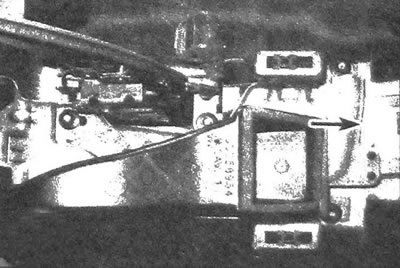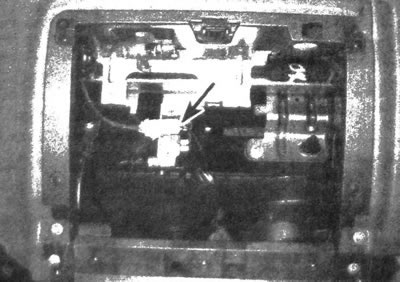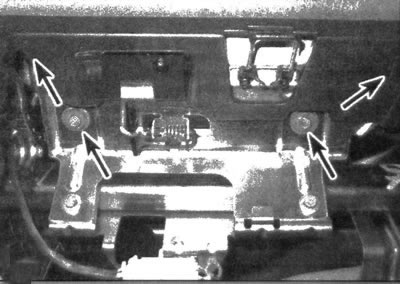
28.1. The SRS control unit is located under the rear of the instrument panel - do not expose the connectors connected to it
Warning: if the car has been flooded, or the trim has become saturated with moisture for any other reason, you must disconnect the battery and do not start the engine until the system has been inspected at a company station. If the SRS system components are exposed to intense moisture, airbag deployment may occur immediately after the engine is started, even if the vehicle has not been subjected to an impact.
Airbags
2. The airbag unit is a chamber with an inflator, which are located in a single housing. The device for inflating the airbag chamber is located at the rear of the body, and is connected to an opening through which air is pumped into the chamber, instantly filling it when an impulse is received from the collision sensor. The driver's airbag unit receives an impulse through a slip ring installed under the unit in the steering wheel. The slip ring is a flat strip that is electrically conductive. The signal to the airbag unit can be received at any position of the steering wheel. Airbags are located in the steering wheel, in the instrument panel above the glove box, and in the backrests of the front seats (side airbags).
Sensing/diagnostic module and sensors
3. The module includes an on-board system microprocessor, due to which the SRS system is automatically monitored. The module also contains a shock sensor. The system is diagnosed every time the engine is started. Moreover, if there is no malfunction in the system, the indicator «AIRBAG» flashes seven times and then turns off. If there is a malfunction in the system, the indicator may not turn on at all, or it may constantly work after turning on intermittently or continuously. A diagnostic code will be recorded in the electronic memory of the microprocessor, which will determine the cause of the malfunction.
4. On the reverse side of the radiator support there are two shock sensors. The side airbags are linked to impact sensors located behind the front door panels and mounted on the interior stiffeners.
System operation
5. Airbag deployment occurs when sensors located on the vehicle body and in the sensing module are activated. When an impact of a certain force and direction occurs, the inflator circuit closes and the pillow deploys.
If the battery is damaged during an accident, or the power supply to the inflator is reduced for some other reason, the system is activated by an internal backup source.
Self-diagnosis system
6. The operation of this system is indicated by an indicator on the instrument panel when the ignition switch is turned to the ON position. If the system is working properly, the indicator will flash approximately seven times and then turn off. If the indicator does not turn on or off within the usual short period of time, or if it turns on during intermittent or continuous driving, there is a malfunction in the SRS system. Contact your dealer immediately to have the problem resolved. Do not try to restore the SRS system yourself, as even the slightest mistake can lead to the airbags not working at a critical moment.
Elements located next to SRS system elements
7. Sometimes it is necessary to remove the steering wheel or car radio, as well as to service elements located near the instrument panel or other elements of the SRS system. Thus, it is necessary to carry out work in areas adjacent to the elements or wires of the passive safety system. Do not connect electrical testers to the SRS wires as this may cause airbag deployment. Before working in the area adjacent to wiring or components of the SRS system, you must turn off the power to the SRS system.
Disabling the system
Warning: Before working in the area adjacent to the wiring or components of the SRS system, you must turn off the power to the SRS system.
8. Disabling is carried out as follows:
- A) Set the wheels to straight ahead and turn the ignition switch to the LOCK position, then remove the key.
- b) Remove the SRS fuse located in the indoor unit on the left side of the instrument panel.
- With) Pause for two minutes until the system's backup power supply is exhausted.
- d) Remove the knee buffer on the driver's side (see chapter 11) and disconnect the driver's airbag connector located on the steering column (see chapter 10).
- e) Open and lower the glove box door (see chapter 11), then disconnect the passenger airbag connector (see illustration).
- f) To deactivate the side airbag, remove the relevant door trim (see chapter 11) and disconnect the side impact sensor connector.

28.8. Disconnect the passenger airbag connector: located behind the glove box
Turning on the system
9. Switching on is done as follows:
- A) Turn the ignition switch to the LOCK position, then remove the key.
- b) Connect the driver and passenger airbag connectors (or side airbag connector). Make sure that the connectors are secured with latches, otherwise they may become disconnected spontaneously.
- With) Install the SRS fuse.
- d) Turn the ignition switch to the ON position. Check that the system alarm indicator flashes for 6-8 seconds and then turns off to confirm that there is no problem with the system.
Removal and installation
Warning: when carrying the air bag unit, turn the side with the lining away from you. Store this item in a safe, isolated place with the lining facing up.
Driver's airbag
10. Disable the SRS system as described in paragraph 8. The procedures for removing and installing the driver's airbag are described in Chapter 10.
Passenger airbag
11. Disable the SRS system as described in paragraph 8.
12. Remove the glove box (see chapter 11). Remove the service cover located on the right side of the instrument panel, and, having access through the opened hole, unscrew the bolts of the air outlet line and move it to the side.
13. Unscrew the lower mounting bolts and unscrew the upper nuts (which are located on each side of the air spring unit and directed forward; Access to fasteners is available from under the instrument panel), then carefully remove the airbag from the instrument panel (see illustration).

28.13. Unscrew the bolts (marked with lower arrows) and nuts (marked with upper arrows; invisible) fasteners and remove the passenger airbag from the instrument panel
Caution: The airbag weighs heavier than its inspection suggests; When removing from the instrument panel, you must support this unit with both hands.
14. Installation is carried out in the reverse order of removal.
Side air bags
15. Some models have side airbags located on the side of the front seat backrests. Replacing these units requires disassembling the seats, so this procedure should be entrusted to specialists from the company or another qualified station.
